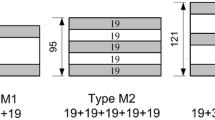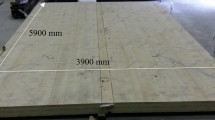Abstract
Cross-laminated timber, typical abbreviations CLT or XLAM, is currently one of the most innovative product in building with wood. This solid engineered timber product provides advantages compared to other solid timber slabs as the dimension stability, i.e. swelling and shrinkage, is controlled by the crosswise laminations. As for other components, the fire resistance has to be verified for this type of product. While fire testing is time consuming and costly, simulations provide flexibility to optimize the product or to develop simplified design models for structural engineers. In this paper, a simulation technique is presented which can be used to determine the fire resistance of CLT. The technique was then used to develop simplified design equations to be used by engineers to predict the behavior of CLT in fire resistance tests and verify its fire resistance. Following existing models, the simplified design model aims for a two-step process whereby in a (i) first step the residual cross section and in (ii) a second step the load bearing capacity of the partly heated residual cross section is determined. The presented simulations consider the effective thermal–mechanical characteristics of wood exposed to standard fire and perform an advanced section analysis using a temperature profile corresponding to the actual protection and the location of the centroid together with the possibility of plasticity on the side of compression. It was shown that simulation results agree well with test results and that they can be used to determine layup specific modification factors used by the reduced properties method or zero-strength layers used by the effective cross section method. It was shown that the use of the zero-strength layers is favorable compared to the modification factors to calculate the resistance of the residual cross section. This is due to the large range of modification factors answering the typical layup of CLT comprising layers with their fiber direction cross the span direction. Subsequently, the methodology was used to determine design equations for initially unprotected and protected three-, five- and seven-layer CLT in bending and buckling. While the zero-strength layer for glulam beams in bending is assumed to be 7 mm (0.3 in), for CLT the corresponding value is in most of the cases between 5 mm and 12 mm but is different for other loading modes such as buckling (wall elements) and depending on the applied protection.
















Similar content being viewed by others
Abbreviations
- b :
-
Width (mm)
- d :
-
Depth for charring related measures (mm)
- E :
-
Modulus of elasticity (N/mm2)
- f :
-
Strength (N/mm2)
- H :
-
Half-length of the window (m)
- h :
-
Depth for member related measures (mm)
- i :
-
Variable
- I :
-
Modulus of inertia (mm4)
- k :
-
Reduction or modification factor
- M :
-
Bending moment resistance (N m)
- n :
-
Number of layers
- l :
-
Length (m)
- q :
-
Heat flux (kW m−2)
- T :
-
Temperature (°C)
- t :
-
Time (min)
- u :
-
Deflection of the bending member
- W :
-
Section modulus (mm3)
- x :
-
Length coordinate along the axis
- α:
-
Convective heat transfer coefficient (Wm−2K−1)
- ε:
-
Emissivity or strain
- κ:
-
Curvature
- ρ:
-
Density (kg/m3)
- 0 :
-
Zero strength and stiffness
- 0.12 :
-
Reference moisture content
- 20 :
-
Normal temperature
- c :
-
Compression
- char :
-
Char
- E :
-
Elasticity
- ef :
-
Effective
- fi :
-
Fire
- f :
-
Strength
- m :
-
Moment (in bending)
- mod :
-
Modified
- t :
-
Tension
- q :
-
Heat flux (kW m−2)
- T :
-
Temperature (°C)
- t :
-
Time (min)
- unexp :
-
Unexposed
- pr :
-
Protection
References
Falk A, Dietsch Ph, Schmid J (2016) In: Proceedings of the Joint Conference of COST Actions FP1402 & FP1404 Cross laminated timber: a competitive wood product for visionary and fire safe buildings, joint conference of COST Actions FP1402 & FP1404 Cross Laminated Timber. KTH Royal Institute of Technology
Schmid J, König J (2010) Cross Laminated timber in fire. SP Report 2010:11, Stockholm
Frangi A, Fontana M, Hugi E, Jübstl R (2009) Experimental analysis of cross-laminated timber panels in fire. Fire Saf J 44:1078–1087
Aguanno M (2013) Fire resistance tests on cross-laminated timber floor panels: an experimental and numerical analysis, Master Thesis, Carleton University, Canada
Hasburgh L, Bourne K, Peralta P, Mitchel P, Schiff S, Pang W (2016) Effect of adhesives and ply configuration on the fire performance of Southern pine cross-laminated timber. In: Conference proceedings of the World Conference on Timber engineering in Vienna, 2016. WCTE 2016, Vienna, Austria
Mestek P, Kreuzinger H, Winter S (2008) Design of cross laminated timber (CLT). In proceedings of the 10th World Conference on Timber Engineering. Miyazaki, Japan
Lie T T (1977) A method for assessing the fire resistance of laminated timber beams and columns. Can J Civil Eng 4(2):161–169
EN 1995-1-2 Eurocode 5: Design of timber structures–Part 1-2: General–Structural fire design (2004) European Committee for Standardization, Brussels
Schaffer E L, Marx C M, Bender D A, Woestel F E (1986) Strength validation and fire endurance of glued-laminated timer beams, Forest Products Laboratory, Research paper FPL 467, Madison
Buchanan A H, Abu A K (2017) Structural design for fire safety. Wiley, New York
Schmid J, König J, Just A (2012) The reduced cross section method for the design of timber structures exposed to fire—background, limitations and new developments. Struct Eng Int 22(4):514–522
Schmid J, König J, Köhler J (2010) Fire-exposed cross-laminated timber-Modelling and tests.” World Conference on Timber Engineering
Franssen J M, Kodur V K R, Mason J (2005) User’s manual for SAFIR 2004—A computer program for analysis of structures subjected to fire. University of Liege, Department Structures du Génie Civil—Service Ponts et Charpentes. Liege, Belgium
Källsner B, König J (2000) Thermal and mechanical properties of timber and some other materials used in light timber frame construction. In: Proceedings of CIB W18, Meeting 33, Delft, Lehrstuhl für Ingenieurbau, University Karlsruhe, Karlsruhe, Germany
Schmid J, Just A, Klippel M, Fragiacomo M (2015). The reduced cross section method for evaluation of the fire resistance of timber members: discussion and determination of the zero-strength layer. Fire Technol 51(6):1285–1309
ISO 834-1 (1975) Fire resistance tests—elements of building construction. Geneva: International Organization for Standardization
Standard test methods for fire tests of building construction and materials (ASTM E 119). West Conshohocken, PA: ASTM.
Babrauskas V (2005) Charring rate of wood as a tool for fire investigations. Fire Saf J 40(6):528–554
Schmid J, Brandon D, Werther N, Klippel M (2018) Thermal exposure of wood in standard fire resistance tests, Fire Saf J
EN 1991-1-2 Eurocode 1: Actions on structures—Part 1-2: General actions—Actions on structures exposed to fire (2002) European Committee for Standardization, Brussels
König J (2004) Structural fire design according to Eurocode 5—design rules and their background. Fire Mater 29(3):147–163
Just A, Joachim S, Ostman B (2012) Fire protection abilities provided by gypsum plasterboards. In: World Conference on Timber Engineering, Auckland, 16–19 July 2012
Schleifer V (2009) Zum Verhalten von raumabschliessenden mehrschichtigen Holzbauteilen im Brandfall. Doctoral dissertation, ETH Zurich, Switzerland
König J, Wallej L (2000) Timber frame assemblies exposed to standard and parametric fires. Part 2: A design model for standard fire exposure. Trätek report I0001001. Stockholm
EN 338:2003 (2012) Structural timber—Strength classes. European Standard. European Committee for Standardization, Brussels
Thunell B (1941) Hållfasthetsegenskaper hos svenskt furuvirke utan kvistar och defekter. Royal Swedish Institute for Engineering Research, Proceedings No. 161, Stockholm
Blass H, Görlacher R (2003) Brettsperrholz–Grundlagen. Holzbau-Kalender 2. (2002) S:580–598. (in German)
Blass H J, Fellmoser P (2004) Design of solid wood panels with cross layers. In: 8th world conference on timber engineering, 14(17):6
Steiger R, Köhler J (2005) Analysis of censored data - examples in timber engineering research. Proceedings of CIB W18, Meeting 38, Karlsruhe, Lehrstuhl für Ingenieurbau, University Karlsruhe, Karlsruhe, Germany
CLT: Handbook Cross-laminated Timber (2013) FPInnovations
ISO 834-1 (1999) Fire-reseistance tests—Elements of building construction—Part 1: General requirements. International Organisation for Standardisation, ISO. Geneva, Switzerland
Östman B, Mikkola E, Stein R, Frangi A, König J, Dhima D, Hakkarainen T, Bregulla J (2010) Fire safety in timber buildings. Technical guideline for Europe. SP. 2010:19
Lineham SA, Thomson D, Bartlett AI, Bisby LA, Hadden RM (2016) Structural response of fire-exposed cross-laminated timber beams under sustained loads. Fire Saf J 31(85):23–34.
Lange D, Boström L, Schmid J, Albrektson J (2014) The influence of parametric fire scenarios on structural timber performance and reliability. SP Report 35. Boras, Sweden
Tiso M, Just A, Klippel M, Schmid J, Brandon D (2017) Zero-strength layers for timber frame assemblies in a standard fire. In: Proceedings of the INTER Meeting 2017, Kyoto. Paper 50-16-3. Karlsruhe, Germany
Konig J (2000) A design model for load-carrying timber frame members in walls and floors exposed to fire. CIB Working Commission 18
Werther N (2016) Einflussgrößen auf das Abbrandverhalten von Holzbauteilen und deren Berücksichtigung in empirischen und numerischen Beurteilungsverfahren. Doctoral dissertation, Technische Universität München
König J, Schmid J (2007) Bonded timber deck plates in fire. Proceedings of CIB W18, Meeting 40, Bled, Slovenia. Lehrstuhl für Ingenieurholzbau, University of Karlsruhe, Karlsruhe, Germany
Kippel M, Leyder C, Frangi A, Fontana M, Lam F, Ceccotti A (2014) Fire tests on loaded cross-laminated timber wall and floor elements. Fire Saf Sci 11:626–639. http://www.iafss.org/publications/fss/11/626
Klippel M, Schmid J, Frangi A (2012) The Reduced Cross section Method for timber members subjected to compression, tension and bending in fire. Proceedings of CIB-W18 Meeting, Växjö, Sweden
Menis A, Fragiacomo M, Clemente I (2012) Numerical investigation of the fire resistance of protected cross-laminated timber floor panels. Struct Eng Int 22(4): 523–532
Acknowledgements
The research described here was conducted at SP Trätek, Stockholm, as a part of the FireInTimber project within the European Wood-Wisdom-Net framework. It is supported by industry through the European Initiative Building With Wood and public funding organizations. The authors would like to acknowledge COST FP1404 where a task group works with this type of product. The test specimens were produced and delivered by Martinsons Trä (Sweden) and Stora Enso Austria. A part of the fire tests were assisted, evaluated and reported by Per Willinder to be included in his Bachelor thesis. The analysis of the reference test results using the Maximum Likelihood Method was conducted by Jochen Köhler.
Author information
Authors and Affiliations
Corresponding author
Appendix
Appendix
See Figs. 17, 18, 19, 20, 21 and 22.
Reduction factors for strength (f) and stiffness (E) properties in (c)ompression and (t)ension acc. to Eurocode 5 [8]
Temperature-dependent stress–strain relationships parallel to the grain for wood at different temperatures with plasticity in compression only [15] (Color figure online)
Rights and permissions
About this article
Cite this article
Schmid, J., Klippel, M., Just, A. et al. Simulation of the Fire Resistance of Cross-laminated Timber (CLT). Fire Technol 54, 1113–1148 (2018). https://doi.org/10.1007/s10694-018-0728-9
Received:
Accepted:
Published:
Issue Date:
DOI: https://doi.org/10.1007/s10694-018-0728-9










